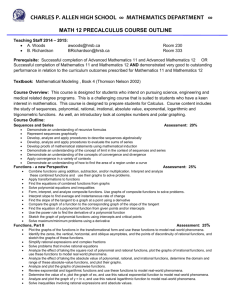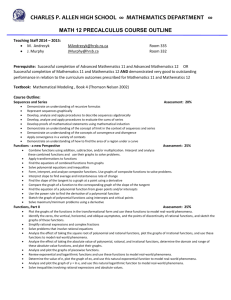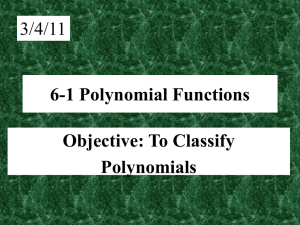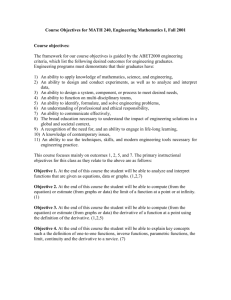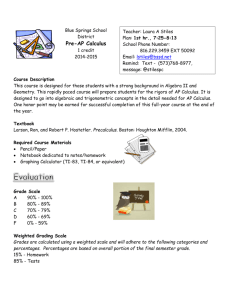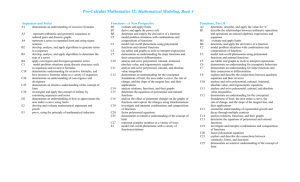Pre-Cal-course
advertisement
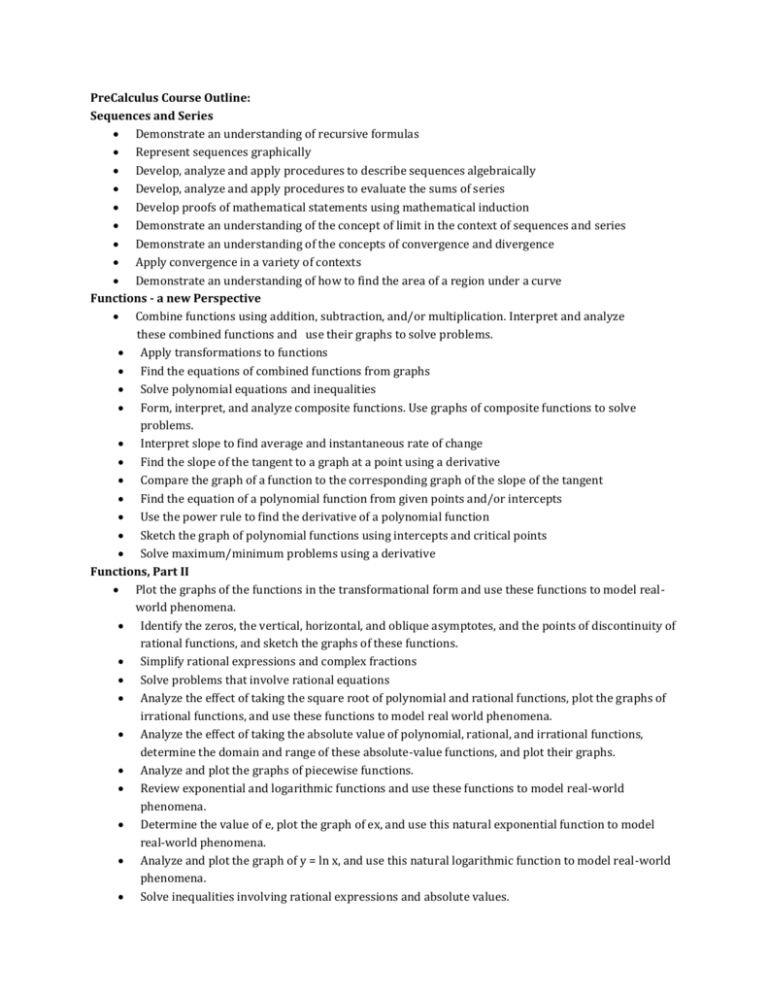
PreCalculus Course Outline: Sequences and Series Demonstrate an understanding of recursive formulas Represent sequences graphically Develop, analyze and apply procedures to describe sequences algebraically Develop, analyze and apply procedures to evaluate the sums of series Develop proofs of mathematical statements using mathematical induction Demonstrate an understanding of the concept of limit in the context of sequences and series Demonstrate an understanding of the concepts of convergence and divergence Apply convergence in a variety of contexts Demonstrate an understanding of how to find the area of a region under a curve Functions - a new Perspective Combine functions using addition, subtraction, and/or multiplication. Interpret and analyze these combined functions and use their graphs to solve problems. Apply transformations to functions Find the equations of combined functions from graphs Solve polynomial equations and inequalities Form, interpret, and analyze composite functions. Use graphs of composite functions to solve problems. Interpret slope to find average and instantaneous rate of change Find the slope of the tangent to a graph at a point using a derivative Compare the graph of a function to the corresponding graph of the slope of the tangent Find the equation of a polynomial function from given points and/or intercepts Use the power rule to find the derivative of a polynomial function Sketch the graph of polynomial functions using intercepts and critical points Solve maximum/minimum problems using a derivative Functions, Part II Plot the graphs of the functions in the transformational form and use these functions to model realworld phenomena. Identify the zeros, the vertical, horizontal, and oblique asymptotes, and the points of discontinuity of rational functions, and sketch the graphs of these functions. Simplify rational expressions and complex fractions Solve problems that involve rational equations Analyze the effect of taking the square root of polynomial and rational functions, plot the graphs of irrational functions, and use these functions to model real world phenomena. Analyze the effect of taking the absolute value of polynomial, rational, and irrational functions, determine the domain and range of these absolute-value functions, and plot their graphs. Analyze and plot the graphs of piecewise functions. Review exponential and logarithmic functions and use these functions to model real-world phenomena. Determine the value of e, plot the graph of ex, and use this natural exponential function to model real-world phenomena. Analyze and plot the graph of y = ln x, and use this natural logarithmic function to model real-world phenomena. Solve inequalities involving rational expressions and absolute values. Trigonometry Express angle measures in terms of arc length Model periodic behavior and solve problems using periodic functions Identify equivalent trigonometric relations Describe transformations of periodic functions to model situations Combine trigonometric functions to create models Use matrix multiplication to rotate images Prove trigonometric identities Solve trigonometric equations Identify the graphs of the reciprocal trigonometric functions Use reciprocal and inverse trigonometric functions and their graphs to solve problems Complex Numbers Explain the connections between real numbers and complex numbers Represent complex numbers in a variety of ways Construct and examine graphs in the complex and polar planes Develop and evaluate mathematical arguments and proofs Apply operations on complex numbers in both rectangular and polar forms Translate between polar and rectangular representations, and investigate the relationships in the operations using graphs Apply De Moivre's Theorem

